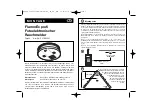
2
A6V10323934_c_en_--
TEMPERATURE – HUMIDITY – PRESSURE - AIR
VELOCITY
The temperature range for the FDOT421 detector is 32°F
(0°C) to 100°F (38°C). Use the detector in environments
where the humidity does not exceed 95% (non-
condensing). Normal changes of atmospheric pressure
do not affect detector sensitivity. The air velocity range is
0-300 ft/min for open areas applications and 0-4000
ft/min for direct in air duct applications. Follow detector
spacing and location requirements in NFPA 72 Chapter
for High Air Movement Areas and Control of Smoke
Spread.
LED INDICATOR OPERATION
The Model FDOT421 contains an LED indicator capable
of flashing either one of three distinct colors: green,
yellow, or red. The microprocessor-based detector
monitors the following:
·
Smoke in its sensing chamber
·
Smoke sensitivity is within the range indicated on the
nameplate label
·
Internal sensors and electronics
Based on the results of the monitoring, the LED indicator
flashes the following:
Flash
Color
Condition
Flash Interval
(Seconds)
Green *
Normal supervisory operation.
Smoke sensitivity is within rated
limits.
10
Yellow
Detector is in trouble and needs
replacement.
4
Red
Alarm
1
No
Flashes *
Detector is not powered, or
replacement is needed.
–
* LED can be turned off. Please follow the corresponding
description of the Panel used.
DETECTOR PROGRAMMING
Each detector must be programmed to respond to an
address between 001 - 252.
To program the detector address, use the Model DPU
Device Programming Unit. Refer to the DPU Manual, P/N
315-033260.
Record the loop and device number (system address) for
the detector on the detector label and on the base to
prevent installing the detector in the wrong base. The
optional DPU label printer can be used for this purpose.
Each detector provides pre-programmed parameter sets
which can be selected by the panel. FDOT421 provides
two different alarm sources which can be selected and
switched on or off individually by the panel. Follow the
corresponding description of the panel used.
Alarm source 1: Combined smoke - heat
·
Standard
·
Duct
NOTE
·
When a FDOT421 with product version
≥
17 is
installed, the parameter setting Robust is changed
to Duct, which shall only be used in-Duct
applications.
·
When using this detector direct in air duct
applications, be sure the detector is set to the
parameter “Duct”.
Alarm source 2: Heat only
·
Fixed 135°F (57°C)
·
Rate-of-rise detection: 15°F/min (8.3°C) at fixed
135°F (57°C)
WIRING
The FDOT421 supports two operation modes: polarity
insensitive mode and isolator mode. The Detector can be
wired for either mode (refer to Figure 2 and 3). During
the isolator mode, the built-in dual isolators will work at
both sides of the Detector to isolate the line short in front
or behind the device.
When the FDOT421 is wired in polarity insensitive mode,
Line -6 and -5 can be either line of the loop.
When the FDOT421 is wired for Isolator mode, the
positive line needs to be connected to 1b and the
negative line to 6. The next device needs to be
connected to 1b and 5.
The Line Isolator is located between connector 6 and 5.
NOTICE
Ensure that the panel supports Isolator mode for
the FDOT421 product version 17.
Isolator mode must not be used with a FDOT421
product version <17. You will find the product
version number on the detector label.
DETECTOR MOUNTING
To ensure proper installation of the detector head into the
base, be sure the wires are properly dressed at
installation:
·
Position all wires flat against the base.
·
Take up all slack in the outlet box
·
Route wires away from connector terminals.
TO INSTALL DETECTOR HEAD
·
Rotate detector counterclockwise while gently
pressing on it until the detector seats fully into base.
·
Then rotate the detector clockwise until it stops and
locks in place. Insert optional locking screw (Order
Model LK-11).
TO REMOVE DETECTOR HEAD:
·
Loosen locking screw, if installed. Then rotate the
detector counterclockwise until stop is reached.
·
Pull detector out of base.
DETECTOR TESTING
Only qualified service personnel should test. To assure
proper operation of the detector, both the Sensitivity and
Functional Test should be conducted. The minimum test
schedule may be found in the current edition of NFPA 72.
SENSITIVITY MEASUREMENT
The sensitivity of FDOT421 detectors can be tested
individually using the DPU. Refer to the DPU Manual,
P/N 315-033260. The sensitivity can be measured by the
panel. Follow the instructions of the panel used.
FDOT421
S54320-F6-A1 17






















